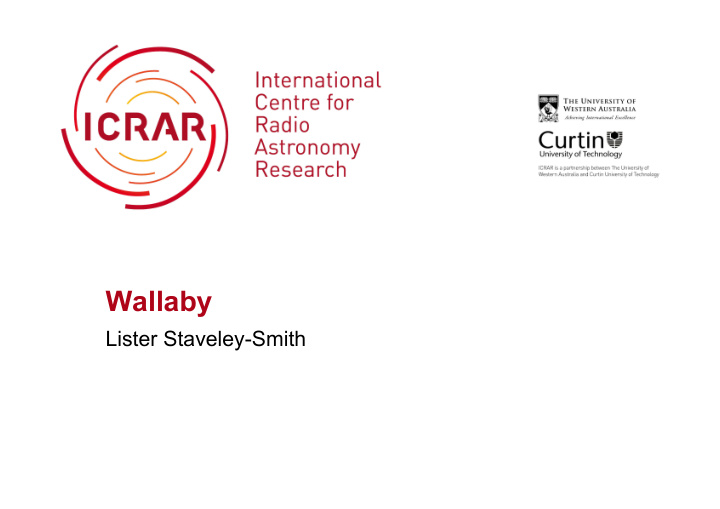



Wallaby Lister Staveley-Smith
Outline • Wallaby/HI science • Wallaby design study – working groups – simulations – techniques – data intensive research pathfinder (DIRP) • Communication, fellowships
LMC • . HI (Kim et al., Staveley- Stars & ionised gas Smith et al.; ATCA/PKS) (Smith; CTIO)
• . LMC/SMC optical (Mellinger) LMC/SMC HI Parkes (Bruens)
Dark and tidal galaxies • ‘Dark’ galaxy VirgoHI21 detected in HIJASS observations (Davies et al. 2004). • Minchin et al. (2005) claim lack of stars (inc.HST) and high rotation velocity suggestive of true dark galaxy. • Other observations (Kent et al. 2007) and models (Bekki et al. 2005; Duc & Bournaud 2008) suggestive of tidal interaction. • ALFALFA Virgo results (Kent et al.) Duc & Bournaud (2008)
Simulations ‘Cold’ gas (blue) flowing into a galaxy at z=3 (Agertz, Teyssier & Moore 2009)
Wallaby (W IDEBAND ASKAP L- BAND L EGACY A LL - SKY B LIND SURVE Y)
Wallaby • A-rated ASKAP Survey Science Proposal (with EMU) • Entered Design study phase
Wallaby: summary • Angular resolution : 30 arcsec (10 arcsec) • Area : 3 π • Bandwidth : 300 MHz (z=0 to 0.26) • Frequency resolution : 18.3 kHz (4 km s -1 ) • RMS flux density (0.1 MHz) : 0.7 mJy/beam • RMS column density sensitivity (0.1 MHz) : 1.7x10 19 cm -2 • Cube volume: 330 TB (4 PB) • uv data volume: 50 PB
Science aims • Local Group – MW halo – low-mass galaxies • Galaxy properties in different environments – HI mass function – Understanding star formation • Cosmology – SkyMapper Tully-Fisher/SN1A dark matter map – Baryon oscillations at z=0
Wallaby: Simulated sky and redshift distribution (Beutler) 500,000 galaxies (670,000 inc. Apertif)
The Local Volume HI Survey (LVHIS) B. Koribalski, A. Lopez-Sanchez, E. Kirby, E. van Eymeren, L. Staveley-Smith, E. de Blok, J. Ott, N. Bonne, Jerjen
Blind HI survey wedding cake • All-Sky (40,000 deg 2 ) – Wallaby (ASKAP) + Apertif (WSRT) + FAST – 500,000 galaxies out to z=0.26 • Medium Deep (1000-5000 deg 2 ) – SDSS (Apertif) • Deep (60-200 deg 2 ) – Dingo (ASKAP) – 100,000 galaxies out to z=0.4 – 150 deg 2 (GAMA/GAMA2 regions) ASKAP • Ultra-deep (2-30 deg 2 ) – Dingo (30 deg 2 out to z=0.4) Apertif – MeerKAT (4 deg 2 out to z=1.4) – [eVLA (clusters at z<0.4)] MeerKAT
Wallaby working groups Alan Duffy talk Matt Whiting talk Tobias Westmeier talk Russell Jurek talk Gerhardt Meurer talk Brad Warren talk Florian Beutler talk related talks
Wallaby simulations • Simulations plan in place – SPH/gadget3 (Duffy, Crain et al.) – Semi-analytic (Baugh, SAX etc) – Semi-empirical (Wilman et al.) • Science simulations • Telescope simulations (Whiting, Serra et al.)
Wallaby simulation: confusion not a problem; non-uniform noise might be. • 30 deg 2 • 32 (ideal) beams • 30 antennas • 2 km baseline • 8 hrs • 92.5 kHz (20 km s -1 ) • SKADS-SAX input catalogue (Obreschkow et al.) ASKAP computing group
• Wallaby/HI science • Wallaby design study – working groups – simulations – techniques – data intensive research pathfinder (DIRP) • Communication, fellowships
ICRAR/Pawsey
Pawsey data intensive research pathfinder: • Post-processing of W ALLABY /D INGO data (after CSIRO Science Archive Facility) • MWA archive • Archive development • Architecture Research and development
• Wallaby/HI science • Wallaby design study – working groups – simulations – techniques – data intensive research pathfinder (DIRP) • Communication, fellowships
Upcoming Wallaby fellowships • 2 SSFs at ICRAR & CSIRO • Phase 2 ICRAR positions inc. ICT
Communications • Meetings • sakai wiki • redmine • Newsletter
Summary • Wallaby design study – in progress: • science simulations • telescope simulations (ASKAP computing group; WSRT) • HI studies with Parkes, Arecibo etc (stacking, imaging) • Source finding algorithms – soon: • visualisation • source parameterisation • detailed survey design • BETA commissioning
Recommend
More recommend